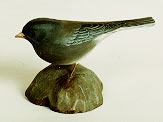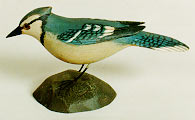by Jim Cullen
New England is a region noted for carvers of miniature wildfowl and songbirds. A.E. Crowell, Joe Lincoln, A.J. King, Russ Burr, Wendell Gilley, Harold Gibbs, R.D. Laurie, Dr. Lewis Webb Hill and Jess Blackstone are among the most prominent. But it’s just in recent years that collectors have grown to appreciate the work of Blackstone, and little information has disseminated concerning the nature and extent of his work. A review of Blackstone’s records at the New Hampshire Historical Society and interviews with knowledgeable sources has provided a glimpse.
Jess Blackstone was born in Melrose, Massachusetts in 1909, living with or near his parents for the first 20 years of his life. After marriage, he and his wife moved to New Hampshire in 1940.
 Blackstone was an excellent ornithologist, and in order that his carving be as lifelike as possible he always collected study birds. So if a bird hit a neighbor’s window, meeting its demise, it found a home in Blackstone’s studio. He also kept a bird watchers life list that dated to the 1920s. Blackstone was an excellent ornithologist, and in order that his carving be as lifelike as possible he always collected study birds. So if a bird hit a neighbor’s window, meeting its demise, it found a home in Blackstone’s studio. He also kept a bird watchers life list that dated to the 1920s.
Jess was a meticulous record keeper. From the early 1940s he recorded the following information for each carving: the date started, finished and sold, the price, the time required for each of the seven stages of carving and painting, and in some cases, where or to whom it sold. Each bird was chronologically numbered according to species.
 The classic Blackstone carving is mounted on a pine oval base, measuring about 1-1/2 inches in diameter and resembling a slate colored rock. The species, the number of the carving and the initials JB is printed in India ink on the bottom of the base. The number of the bottom indicates the chronology of the species. For instance, the number 4 on the base of a robin would indicate it is the fourth robin he made. His records indicate that numbers one through six were made in 1947. During 1963 and 1964 Blackstone began placing the year before the number. Consequently birds made during those years may have a number such as 63424 for a bluebird and 641931 for a chickadee. Some of the numbered birds contain an additional "DW number. A DW number, such as DW6603, indicates it was a gift given in 1963 and the third given that year. In addition, some of his circa 1960 carvings also include the words "Concord, N.H." on the bottom. The classic Blackstone carving is mounted on a pine oval base, measuring about 1-1/2 inches in diameter and resembling a slate colored rock. The species, the number of the carving and the initials JB is printed in India ink on the bottom of the base. The number of the bottom indicates the chronology of the species. For instance, the number 4 on the base of a robin would indicate it is the fourth robin he made. His records indicate that numbers one through six were made in 1947. During 1963 and 1964 Blackstone began placing the year before the number. Consequently birds made during those years may have a number such as 63424 for a bluebird and 641931 for a chickadee. Some of the numbered birds contain an additional "DW number. A DW number, such as DW6603, indicates it was a gift given in 1963 and the third given that year. In addition, some of his circa 1960 carvings also include the words "Concord, N.H." on the bottom.
 Because Jess carved jointly with his father and had a brief association with Fieldcraft, carvings should only be attributed to him if they contain his initials and coding number. In addition to the familiar carvings, Blackstone also made miniature swimming waterfowl, multiple miniature mounts of waterfowl, flying wall mounts and numerous terns and seagulls displayed on driftwood. Because Jess carved jointly with his father and had a brief association with Fieldcraft, carvings should only be attributed to him if they contain his initials and coding number. In addition to the familiar carvings, Blackstone also made miniature swimming waterfowl, multiple miniature mounts of waterfowl, flying wall mounts and numerous terns and seagulls displayed on driftwood.
In the early 1940s Jess and his father also collaborated on miniature birdhouses with a songbird perched on the front. The birdhouses bore the Blackstone paper label on the back.
Blackstone was a talented, trained and accomplished artist. He had a sure hand and worked quickly. His ornithological background, combined with his artistic abilities, enabled him to produce a miniature bird carving that was correct and complete. The essential feathers are placed with no excess interpretation, resulting in a clean, meticulous rendition with no wasted effort.
 In an excellent month Blackstone could complete up to 60 carvings, but the average monthly production was 30 to 40 pieces. Occasionally there was no production because of attention to other projects. Jess carved and painted most American species of songbird and waterfowl. Shorebirds, gamebirds and owls are more rare. But it’s the songbirds that are most common, with over 92 different species recorded in his records, including 13 from the sparrow family and 25 in the warbler family. In an excellent month Blackstone could complete up to 60 carvings, but the average monthly production was 30 to 40 pieces. Occasionally there was no production because of attention to other projects. Jess carved and painted most American species of songbird and waterfowl. Shorebirds, gamebirds and owls are more rare. But it’s the songbirds that are most common, with over 92 different species recorded in his records, including 13 from the sparrow family and 25 in the warbler family.
Blackstone began numbering his birds consistently in 1946, after returning from Europe, but his notebook records the differing species from 1940. Consequently, Chickadees listed in the records, such as numbers 1-5, may not be actually numbered on the bases. But the numbers do give collectors a gauge of the rarity of any given species. Blackstone made 2510 chickadees, 587 bluebirds, 557 goldfinch, 454 mallard drakes, 458 red-breasted nuthatch, 371 white-breasted nuthatch, 306 golden0-crowned kinglet, 292 purple finch, 290 ruby-crowned kinglet, 267 robins, 172 Canada geese, 170 mounted flying gulls, 164 white-throated sparrow, 154 myrtle warbler, 124 evening grossbeak, 117 Baltimore orioles and 113 yellow-throated warbler. All other species were produced in quantities of less than one hundred.
 In 1980 Blackstone’s production dropped dramatically. By the time he stopped carving, his lifetime’s production was estimated between 8,500 and 8,750 carvings, not including his work for Fieldcraft or the combined efforts with his father. In 1947 a miniature bluebird cost $2.00; by the early 1980s Jess was charging $50 for a blue jay, $45 for a nuthatch and $95 for a wood duck. In 1980 Blackstone’s production dropped dramatically. By the time he stopped carving, his lifetime’s production was estimated between 8,500 and 8,750 carvings, not including his work for Fieldcraft or the combined efforts with his father. In 1947 a miniature bluebird cost $2.00; by the early 1980s Jess was charging $50 for a blue jay, $45 for a nuthatch and $95 for a wood duck.
Blackstone died in February 1988. Although his obituary lists his name as Jesse D. Blackstone, documents indicate that the spelling Jess was more commonly used. He was 78 years old.
A special thanks to Howard Waddell, Cheryl and Paul Scott, Elaine Haid, Russ Goldberger, Randy Root, Gigi Hopkins, Nacy Jo Charbot, David Smolen and Martha Lovejoy for their assistance.
For the complete story, please see the July/Aug. 2001 issue of Decoy Magazine.
Tidbits Main Index

|


